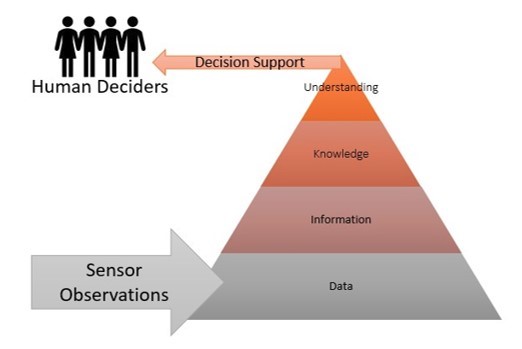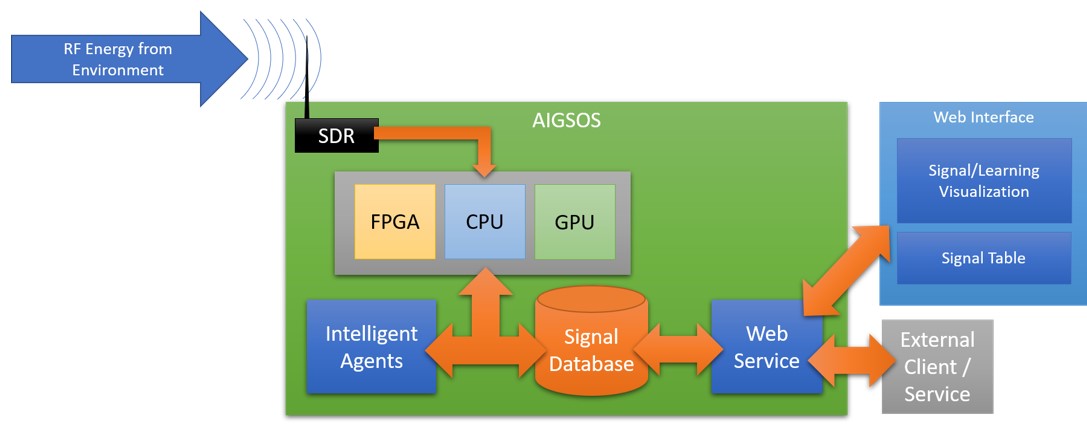
From autonomous vehicles to autonomous markets, it’s becoming increasingly clear that solutions consisting of autonomous artificially intelligent (AI) agents are changing the way we get things done. Due to continuing advances in the field of machine learning (ML) and AI, computer systems can now “discover” hidden insights within data, exposing hidden relationships and conclusions normally obscured by the complexity and enormity of the available data.
Electromagnetic spectrum operations, like many other domains that rely on the monitoring of sensor observations, has a history that starts with manual, human attention–centric operations, transitions to “person in the loop”-style systems (where automated processes are verified and checked by the human operator), and is currently moving toward automated systems, where a human user takes a more supervisory role. This transition of activity from human to machine is happening for a good reason: what autonomous systems lack in ingenuity, they make up for in untiring and unrelenting attention and speed.
Big Spectrum, Bigger Data
This combination of speed and near-limitless attention to detail are vital for operations involving the electromagnetic spectrum, due to both the vastness of the spectrum (radio frequency [RF] communication, visible invisible/light, etc.) and the sheer amount of data being transferred within it. AI/ML technology and the supporting advances in computing hardware allow for the creation of tools that act as force multipliers, allowing the beneficial properties of large data sets while providing the human decision-maker on the other end with a higher level of understanding of the meaning of its contents.

Effectively characterizing, understanding, and shaping the usage of the electromagnetic spectrum requires autonomous systems capable of the high-speed acquisition of sensor data and the capability to refine the most relevant data into data products providing decision support. Performing data refinement at the tactical edge in a small size, weight, and power envelope is no small feat. For example, the wideband analysis required to perform RF survey requires “big data” processing capabilities on the order of 1 to 10 Terabytes of data composed of high volume, velocity, and variability. Maintaining full awareness of the data being acquired by QRC Technologies WBT software-defined radio platform requires sustained processing of 1.6 gigabytes per second. To give a better sense of scale, this is about four Blu-ray discs worth of data per minute.
QRC Technologies Solution
QRC Technologies response to this challenge is the to provide an AI Guided Spectrum Operations System (AIGSOS): a collaborative, multi-agent system that employs state-of-the-art hardware and software capabilities to continually optimize system resources and observation opportunities to progressively refine our customers’ awareness of the electromagnetic spectrum environment.
The system employs attentive, intelligent agents applying processing and learning algorithms to progressively refine raw sensor data into enhanced RF situational awareness. The system is both a software and hardware solution, readily configured to operations of any scale, from small-form-factor tactical to multisite enterprise deployments.
The following diagram represents the high-level data flows and system elements of AIGSOS. The solution consists largely of software-defined radio (SDR), the platform computes capabilities, and the software that runs on the platform (intelligent agents, database, and web service).

From the moment the system is introduced to the environment, AIGSOS goes to work, automatically detecting signals, extracting them, and putting it all into a database. Upon the introduction of RF signals, a swarm of GPU-accelerated, intelligent agents rapidly assemble the pieces needed to provide relevant decision support information.
The following is a list of examples of decision support information:
What RF emitters are in the area?
- How many are there?
- What are they?
- Where are they?
- What kind of data is being transported?
- Can a communications network be inferred from these signals’ traffic?
Data Acquisition And Preprocessing
AIGSOS begins its process at the wideband software-defined radio (SDR) layer, where it undergoes a series of filtering and processing steps to ensure that we’re only capturing the appropriate bands, and with the cleanest possible capture.
After acquiring data from the SDR, AIGSOS’s detector uses GPU-accelerated methods to detect signals, separating them from the noise in the RF environment. After detection, GPU-accelerated signal-processing methods are used to extract the narrowband signal from the main data stream.
Our approach results in the extraction of 100-plus independent stationary signals per second and thousands of pulses across multiple frequencies. Removing the noise and only keeping the signal in this manner reduces the data to a few megabytes of data rather than gigabytes. The technique benefit is twofold; significantly reduces the local storage, processing needs, feature extractors while increasing the fidelity of information for the user.
Intelligent Classification Agents And Feature Extractors
In the AI Guided Spectrum Operations System, the role of an intelligent classification agent is to transmute data elements in the database into actionable answers by employing classifiers to generate features using online learning models or pretrained models’ supervised algorithms.
During the system’s runtime, intelligent agents monitor the signal database in search of the relevant training information they need (either from groups of RF energy pulses or persistent long-period signals) to use its classifier/regressor to formulate a data point needed by a system operator or by another intelligent classification agent. In cases where there are inadequate data for the agent to come to an “answer,” the agent must perform one of the following tasks:
- Call upon a feature extractor, which uses digital signal processing/statistical and unsupervised means to generate data from one or more data points
- Invoke another intelligent classification agent
The process is engineered with a decidedly top-down approach, focusing on the end-stage data products and allowing the system to self-organize to achieve the intermediate stages.
It’s not a requirement that all agents and feature extractors must be collocated. Because of the use of standard database technologies for the signal database instances, it’s possible for the system to scale-out beyond the capability of a single machine for the purpose of acquiring and processing signals. In addition to multiple meshed stand-alone systems operating in unison, this also means that cloud-type resources could improve the decision-making capabilities as well.
In sum, the intelligent classification agents monitor databases, continually ensuring that they either have the data they need to perform classification tasks or that the right agents and feature extractors are working to provide that data. The net result of the work of these agents is a constantly refined and improving picture of the RF environment.
Reporting And Visualization
One of the operating principles of the AI Guided Spectrum Operations system is to perform the bookkeeping required to ensure that the data-pedigree of each decision is fully intact. This means that users can inspect and verify all data contributing to every decision made by the system. Fitting the various features and associated models with web-based, 3D accelerated visualization tools, we give the user a clearer picture of what is going on “inside the box” in a way that many AI/ML-driven systems do not.
In a world where decisions are increasingly data-driven and rapid, but also where there’s a greater need for accountability, the AI Guided Spectrum Operations employs visualization and reporting mechanisms to communicate not only what conclusions were reached, but the level of confidence and the manner by which the system came to its answers.
The utility of an AI-based system is only as good as the trust that its users have in the system. It is vitally important that the system provides a window into its decision-making process in a way that is understood rapidly, at least partially, by the recipients of potentially actionable information. Government agencies are beginning to draft policies surrounding AI. In fact, CISA recently announced that it will require certification for its systems and DARPA is researching explainable AI referred to by the popular press as “AI Ethics”. QRC Technologies, a Parsons Company, continues to collaborate with industry partners and the government on its AI investments as these regulations and policies begin to emerge. The topic of AI ethics will be the subject of a follow-on article.
Scalability Ranging From The “Pack To The Rack”
Our team has delivered RF products of all shapes, sizes, and power requirements for over thirty years. This includes man-portable and fixed-location wireless sensing and survey equipment as well as UAV and ground-vehicle-mounted configurations. The AI Guided Spectrum Operations system’s hardware platforms are the next evolution of our capabilities and continued focus on our customer’s missions.
We recognize that not all decision support systems have the same requirements and constraints. By employing open architecture and web-based communications standards, the AI Guided Spectrum Operations system is designed to work seamlessly with third-party sensors and platforms, thus allowing end-users to take the state of the art capabilities to the tactical edge.
What’s Next
We continue to invest in helping our clients characterize, survey, and understand the interwoven, complex relationships between base stations; devices; bad actors; and, sometimes, just an inadvertent network misconfiguration or interference issue. To understand these RF environments, most vendors rely upon vast signal libraries to detect waveforms by utilizing a lookup-table methodology. We’ve taken a different approach by building patent-pending AI/ML algorithms that detect and identify signals using unsupervised learning—even in the noisiest of environments. Our current capabilities allow for the detection and identification of frequency-agile-based signals (e.g., drones, telemetry, and other pulsed or frequency-hopping communications) and allow for other advanced signal detection and manipulation on man-portable low-SWaP (size, weight, and power) devices.
We’ve just begun our journey of becoming part of the Parsons family and will be coming up on our one-year anniversary in August. We’re hard at work to bring more capability to our customers in an even smaller size, weight, and power envelopes, including leading-edge 5G and IoT capabilities. We’re also well underway combining our signals expertise with the cyber, space, and other multi-domain teams at Parsons to provide seamless interoperability between next-generation offerings and the deployed solutions. The future is bright, and we look forward to the capabilities we’ll be able to deliver to our clients in the coming months.
Conclusion
Although we’ve briefly touched on some of the AI capabilities of our RF systems, we are continuing to invest in our data science technology, people, and strategy. In part two of our Spectrum Operations series, we’ll talk about our approach to AI ethics and how we’re building better transparency and accountability into all our autonomous systems.